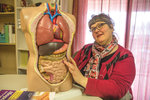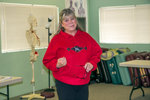Adele Lafever of Port Townsend yearns to help others heal through massage, and she’s seeking to earn her certification to pursue a career in the field.
“I absolutely love the connectivity of touching people’s bodies and lives,” said Lafever, a student at Port Townsend School of Massage, 1071 Landes Court in Port Townsend.
This item is available in full to subscribers.
We have recently launched a new and improved website. To continue reading, you will need to either log into your subscriber account, or purchase a new subscription.
If you had an active account on our previous website, then you have an account here. Simply reset your password to regain access to your account.
If you did not have an account on our previous website, but are a current print subscriber, click here to set up your website account.
Otherwise, click here to view your options for subscribing.
* Having trouble? Call our circulation department at 360-385-2900, or email our support.
Please log in to continue |
|



Adele Lafever of Port Townsend yearns to help others heal through massage, and she’s seeking to earn her certification to pursue a career in the field.
“I absolutely love the connectivity of touching people’s bodies and lives,” said Lafever, a student at Port Townsend School of Massage, 1071 Landes Court in Port Townsend. “I would say that people come to massage for a lot of different reasons, and I am excited to meet people where they are for healing, and am pursuing that type of work.”
Lafever is one of about 800 students to pass through the halls of PTSM since 2004, said Susan Sherman, who bought the school that year from founder Fairn Woods.
Sherman’s goal is to teach each student what they can do to help ease others’ suffering.
“People often think, ‘Well, it’s a back rub. What’s up with that?’” Sherman said. “No, actually, it’s not. We are greatly affecting someone’s health, or their health condition greatly affects what we need to do for them. There is a tremendous amount of science behind it. That is what we want to pass on in terms of knowledge.
“It is a lot of science,” she added. “It is a lot of anatomy, a lot of kinesiology and a lot of pathology. Yes, it is a whole lot of hands-on, but they absolutely have to know the background of the bodies.”
An untrained masseuse can be dangerous, Sherman said.
“When you are really doing this, if you have medical conditions you are working around, there is potential for harm,” she said. “We have the same credo of do no harm that any medical professional has. In Washington state, we are health-care providers. That is a very big distinction between many other states.”
To earn their state certification, students have to complete a minimum of 500 hours, Sherman said. The school has two options for obtaining those hours.
“Right now we have a nine-month, full-time program, and we have a 14-month, part-time program,” Sherman said.
“It is a learned and managed healing art,” she said. “We find there is a real calling for this field because you want to help people. You want to work with people.”
Treating the individual
“Our students might get individuals that have medically frail conditions,” Sherman said. “What I hear the most (is), ‘People are afraid to touch me.’ Oh gosh, that just makes me cry because human touch is what we need. The loneliness of that is outrageous. We don’t have to fall into that.”
Sherman teaches her students to be compassionate and to tailor therapy to each patient.
“Even when they are medically frail, it is not about what we can’t do for them,” she said. “We will teach what you cannot do, and why you cannot. But what we really want to focus on is all the other things of what you can do. How can you connect with that person? How can you make them feel heard, attended to? How can you be present with them?”
Even if a full-body massage is out of the question, there are other techniques available such as focusing on the head, hands or feet, Sherman said.
“It is not about focusing on what you cannot do for someone, it is about focusing on what you can do for someone,” Sherman said. “I love that, and we are phenomenally strong on that.”
Elizabeth Piglowski, PTSM assistant director and instructor, teaches deep-tissue massage and kinesiology. In addition to treating ailments, a well-performed massage can help keep an individual healthy, she said.
“It is also maintaining good health,” Piglowski said. “A lot of people tend to think of massage as just an injury-related modality, and really it is for longevity. It is preventative. I call it a maintenance plan. Come in once every four to six weeks. Anything that has moving parts, a little maintenance goes a long way. A massage, even once a year, you are doing something for you. You are staying connected with your body.”
Healing hands
“We thoroughly believe in the power of massage therapy,” Piglowski said. “A lot of people have a preconceived notion of massage, that it is very light, it’s very fluffy. It’s a nice luxury if you can afford it. Really, massage has so much more to it.”
“Touch in and of itself is very basic,” Piglowski added. “Touch is stimulus, whether you are using a light modality or a deeper modality.”
What the PTSM students learn is how touch can affect all the body’s systems, Piglowski said.
“It doesn’t feel good just because you are rubbing muscles,” Piglowski said. “You are affecting everything, the muscular system, the skeletal system, the nervous system and the lymphatic system. All of it.”
Sometimes, the best course of action is to do no massage, a decision that is up to the therapist, Piglowski said.
“Sometimes just when you think, ‘Massage is the thing I need,’ it actually might be the last thing you need, depending on what is going on with the body,” she said. “If someone has the flu, they get aches and pains. I have had people walk into my office wrapped in blankets with thermometers hanging out of their mouths saying, ‘I’ve got the flu. I am very achy. I just know a massage will make me feel better.’ In reality it is the last thing (they need). The whole body is amped up to handle a virus or a bacteria, and a massage can actually make you feel worse.”
In that case, a massage should be reserved for when the illness subsides, Piglowski said.
“It is for the same reason when you are coming off of the flu or a cold, you go in and get a massage, and it will help you feel better because it helps you phase out whatever is happening.”
Such knowledge comes through education and experience, Piglowski said.
Getting certified
When students leave the school, they have the basic foundation in place to practice in the field, Piglowski said.
“Students leave here knowledgeable,” she said. “They have exactly what they need to move forward because there is so much to know. Here you will get what is required by the state, but also the critical-thinking skills that go into it because, just when you think you have seen this scenario before, one small change to that scenario completely changes it.”
Piglowski graduated from PTSM in 2002.
“I opened a practice, and though I felt incredibly novice at the time, everything keeps building,” she said.
“And of course, with continuing education, which we offer here, there is more opportunity to learn more,” Piglowski said. “Everybody is so vastly unique, we need to be more engaged with the uniqueness of that body rather than just the modality or just the book learning. We have to pay attention to the uniqueness of the individual.”
The treatment plan for a person may change over time as well, Piglowski said.
“Each treatment plan is its own unique being,” she said. “I can see the same client every week like clockwork for eight years, and each session is going to be unique because nobody feels the same or is the same person in every moment of the day. I have to attend to how you are in this moment right now, no matter how much I know you or how long we have worked together.”
Founding the school
PTSM was founded in 1995 by Fairn Woods as an apprenticeship with three students, Sherman said. In 1996, it became a full fledged school. The were in the Pane D’Amore bread shop uptown for a time.
“Woods is the one that had the initial vision,” Sherman said. “She got the ball rolling.”
Sherman said she was the director when the school was still located uptown.
“The funny thing about uptown was you had to make sure you positioned the massage tables correctly because the lean on the floor was so heavy,” Sherman said. “They did a lot of work.”
In 2002, the school bought the former bed-and-breakfast in which it is now located next to the Safeway.
“They had a machine shop downstairs so we gutted everything,” Sherman said.
For more about PTSM, call 360-379-4066 or visit its website.